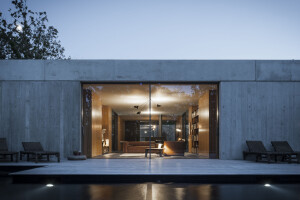In the new Tübingen urban quarter “Alte Weberei”, eight families have inexpensively realised their individual ideas of living in a housing cooperative “en famille”. Collectively, they discussed and decided not only the construction but also the design of the family-oriented house. For flood protection reasons, the L-shaped building stands heightened on a raised platform with one of its distinctive corners pointing towards the “Egeriaplatz” (public place of the quarter). The attractive inner courtyard is being used by all residents. A large part of the building consists of maisonette-apartments; balconies, bay windows, winter gardens, and differently sized roof terraces enhance the value of the apartments. With regard to energy efficiency, the building reaches the KFW-70 standard, because it is heated by the waste heat from electrified biogas. The surface-low windows of two widths are arranged according to the needs of the different apartments and enliven the monolithic brick facade. The building is plastered with ecological lime mortar which is dyed with brick dust, thus the usual biocides can be dispensed. Above the upper windows, there are darkened fields of plaster which loosen up the roof edge. The base is done in dark roughcast. Where the windows of the commercial units and the entrances are, this rough plastering reaches up to the first floor framing these public areas. The manually executed edges of the plastering without any bars make the building rather plastic and cubic. The untreated larch wood at the bay windows, balconies and window sills places another warm mark. The washed stair case is like a walkable sculpture with refined guidance of paths and daylight. Since there was no lift put in, it could be placed freely within the house and ends in a little place with some seatings. Its spatial backbone consists in a light-well which is emphasised by an ornament of primed lime surface. The apartments are also washed or plastered smoothly and painted with lime in order to ameliorate the room climate. Again and again one can discover refined details, like the exactly detailed handrails, the stair treads hung up on steel poles and light accents caused by roof-lights. Behind the large windows of the basement, there is the self-organised café „viertel vor“ and the ceramic shop floor Alawari. The conceptually singular shared shop offers self made kids' cloths, lamps, jewlery, accesoires, postcards and plush toys. The café at the corner of the building opens up towards the urban place. The playing platform of the children's area can be turned into a small stage. In the afternoon and on sundays, coffee and fine cake is served, complemented by a broad range of special events like nepalese food, St. Nicolaus barbecue or private parties. Already at present, there is much positive feedback on the colourful cultural and culinary offer - from the quarter and for the quarter. The esthetically remarkable building invites downrightly for this ambitioned and pulsating usage.
Housing Cooperative “en famille”, Tübingen
Share or Add Housing Cooperative “en famille”, Tübingen to your Collections
































